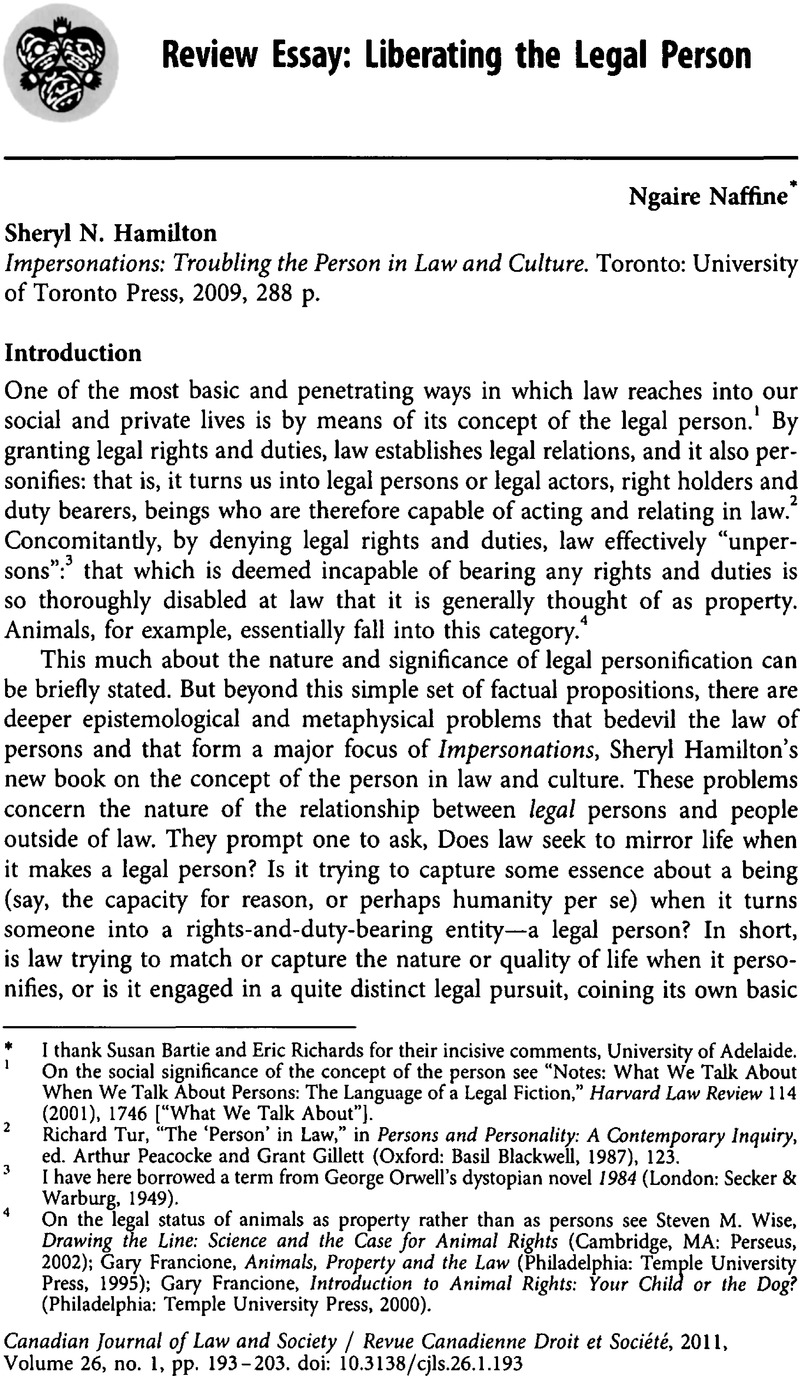Article contents
Review Essay: Liberating the Legal Person
Published online by Cambridge University Press: 02 January 2013
Abstract

- Type
- Review Essay
- Information
- Canadian Journal of Law and Society / La Revue Canadienne Droit et Société , Volume 26 , Issue 1 , April 2011 , pp. 193 - 203
- Copyright
- Copyright © Canadian Law and Society Association 2011
References
1 On the social significance of the concept of the person see “Notes: What We Talk About When We Talk About Persons: The Language of a Legal Fiction,” Harvard Law Review 114 (2001), 1746Google Scholar [“What We Talk About”].
2 Tur, Richard, “The ‘Person’ in Law,” in Persons and Personality: A Contemporary Inquiry, ed. Peacocke, Arthur and Gillett, Grant (Oxford: Basil Blackwell, 1987), 123Google Scholar.
3 I have here borrowed a term from Orwell, George's dystopian novel 1984 (London: Secker & Warburg, 1949)Google Scholar.
4 On the legal status of animals as property rather than as persons see Wise, Steven M., Drawing the Line: Science and the Case for Animal Rights (Cambridge, MA: Perseus, 2002)Google Scholar; Francione, Gary, Animals, Property and the Law (Philadelphia: Temple University Press, 1995)Google Scholar; Francione, Gary, Introduction to Animal Rights: Your Child or the Dog? (Philadelphia: Temple University Press, 2000)Google Scholar.
5 This is a set of questions that I have also posed in Naffine, Ngaire, Law's Meaning of Life: Philosophy, Religion, Darwin and the Legal Person (Oxford: Hart, 2009)Google Scholar.
6 This being is well exemplified in criminal law and contract theory. For an account of this person in criminal law see Gardner, John, “The Mark of Responsibility,” Oxford Journal of Legal Studies 23 (2003), 157CrossRefGoogle Scholar. It is even more clearly evident in Moore, Michael, Placing Blame: A General Theory of the Criminal Law (Oxford: Clarendon Press, 1997)Google Scholar The male pronoun is used deliberately because the rational adult has tended to be thought of as a man.
7 Nekam, Alexander still provides the clearest and most sustained defence of this idea of the person in The Personality Conception of the Legal Entity (Cambridge, MA: Harvard University Press, 1938)Google Scholar.
8 See Hart, H.L.A., The Concept of Law, 2nd ed. (Oxford: Clarendon Press, 1994)Google Scholar.
9 Kramer, M.H., “Do Animals and Dead People Have Legal Rights?” Canadian Journal of Law and Jurisprudence 15 (2001), 29, 36Google Scholar.
10 See Grear, Anna, “Challenging Corporate Humanity: Legal Disembodiment and Human Rights,” Human Rights Law Review 7 (2007), 511Google Scholar.
11 For an analysis of the idea of the bounded body as the paradigm body see Nedelsky, Jennifer, “Law, Boundaries and the Bounded Self,” Representations 30 (1990), 162CrossRefGoogle Scholar.
12 On the tendency of standard models of the person to “strand” pregnant women see Ford, Mary, “A Property Model of Pregnancy,” International Journal of Law in Context 1 (2005), 261CrossRefGoogle Scholar.
13 Nekam, The Personality Conception of the Legal Entity, offers an entire book about persons in which he endeavours to empty the term of its metaphysical content and to reserve it for law. He even suggests that in order to emphasise the pure artifice of law, and its technical mode of personification, we abandon such words as “person” and “subject” altogether, and replace them with the term “legal entity,” precisely to get away from any implication apparently contained in these words that law deals in natural beings.
14 Lawson, F.H., “The Creative Use of Legal Concepts,” New York University Law Review 32 (1957), 913Google Scholar.
15 As Bryant Smith expressed this point of view, ‘To regard legal personality as a thing apart from the legal relations, is to commit an error … Without the relations … there is no more left than the smile of the Cheshire Cat after the cat had disappeared.’ Smith, Bryant, “Legal Personality,” Yale Law Journal 37 (1928), 294CrossRefGoogle Scholar.
16 See Naffine, Ngaire, “Who are Law's Persons? From Cheshire Cats to Responsible Subjects,” Modern Law Review 66 (2003), 346CrossRefGoogle Scholar; see also Naffine, Ngaire, “Our Legal Lives as Men, Women and Persons,” Legal Studies 21 (2004), 621CrossRefGoogle Scholar. Hamilton also adopts this P1 terminology.
17 This problem of definitional vagueness is examined in “What We Talk About.”
18 For a clear illustration of the view that the rational agent is the paradigmatic rights holder and legal person see Kramer, , “Do Animals and Dead People Have Legal Rights?,”, 36Google Scholar.
19 This character is the subject of detailed analysis in Lloyd, Genevieve, The Man of Reason: “Male” and “Female” in Western Philosophy (London: Methuen, 1984)CrossRefGoogle Scholar.
20 For a more sustained analysis of the deficiencies of the legal individualism implicit in many applications of the concept of the legal person see Davies, Margaret and Naffine, Ngaire, Are Persons Property? Legal Debates about Property and Personality (Aldershot, UK: Ashgate, 2001)Google Scholar.
21 This observation is well made in Meyerson, Denise, “Persons and Their Rights in Law and Morality,” Australian Journal of Law and Philosophy 35 (2010)Google Scholar.
22 Law already does this. Foetuses, for example, can be beneficiaries, and hence persons, for the purpose of the law of inheritance, but then regarded as part of the body of a woman, part of her person, for the purposes of the laws of assault or of insurance law, so that a deliberate harm to the foetus is treated as harm to the woman. The legal identity of the foetus is not fixed but shifts according to perceived legal need.
23 Fuller, L.L., “Legal Fictions,” Illinois Law Review 25 (1930), 377Google Scholar.
24 Ibid., 370.
- 6
- Cited by




